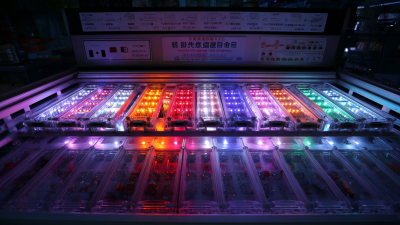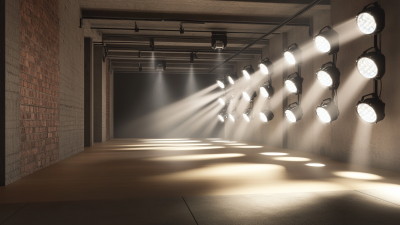How to Maximize Energy Efficiency with LED Lighting: Insights from Industry Studies
As the demand for energy-efficient solutions continues to rise, LED lighting has emerged as a transformative technology capable of significantly reducing energy consumption and costs. This guide explores how to maximize energy efficiency with LED lighting, drawing insights from industry studies that highlight best practices and innovative applications. LED lighting not only lowers electricity bills but also offers longer lifespan and reduced environmental impact when compared to traditional lighting options. Understanding the various factors that influence energy efficiency, including proper installation, optimal design, and effective usage strategies, can empower consumers and businesses alike to harness the full potential of LED technology. By adopting these strategies, stakeholders can contribute to sustainability efforts while enjoying the myriad benefits that come with efficient lighting solutions.

Understanding LED Technology and Its Benefits for Energy Efficiency
LED technology has fundamentally transformed the landscape of energy-efficient lighting, presenting numerous benefits that go beyond mere brightness. One of the most significant advantages of LED lighting is its ability to consume substantially less energy compared to traditional light sources. As industries strive to lower their energy consumption and operational costs, integrating LED solutions has become increasingly appealing. The longevity of LED bulbs also contributes to their efficiency, as they reduce the frequency of replacements, leading to less waste and lower maintenance costs.
Recent advancements in LED technology, such as the development of Mini and Micro LED options, further enhance energy efficiency while improving visual quality. These newer technologies offer exceptional brightness, contrast, and responsiveness, making them ideal for applications ranging from consumer electronics to advanced lighting solutions in agriculture and industrial settings. The transition to LED lighting, particularly in conjunction with innovative technologies, signifies a major step toward maximized energy efficiency and sustainability across various sectors.

Key Strategies for Implementing LED Lighting in Various Settings
 Implementing LED lighting is a key strategy for enhancing energy efficiency across various settings, including residential, commercial, and industrial environments. One of the most effective approaches is conducting a comprehensive energy audit to assess current lighting usage. This audit helps identify areas where outdated lighting can be replaced with LED fixtures, ultimately leading to significant energy savings.
Additionally, it's crucial to consider the placement and design of lighting to maximize its benefits. For instance, using motion sensors and dimmers in hallways and conference rooms ensures that lights are only on when needed.
Implementing LED lighting is a key strategy for enhancing energy efficiency across various settings, including residential, commercial, and industrial environments. One of the most effective approaches is conducting a comprehensive energy audit to assess current lighting usage. This audit helps identify areas where outdated lighting can be replaced with LED fixtures, ultimately leading to significant energy savings.
Additionally, it's crucial to consider the placement and design of lighting to maximize its benefits. For instance, using motion sensors and dimmers in hallways and conference rooms ensures that lights are only on when needed.
Another important strategy involves educating employees and residents about the advantages of LED lighting. Raising awareness through training sessions or informational materials fosters a culture of energy efficiency. It also encourages behavioral changes that complement the technical upgrades, such as turning off lights when leaving a room. Furthermore, collaborating with energy-efficient lighting manufacturers can provide valuable insights into the latest technology and best practices, ensuring that the transition to LED is not only seamless but also maximizes energy savings in the long run.
Evaluating Energy Savings: Metrics and Tools for LED Performance
Evaluating energy savings through LED lighting involves a comprehensive analysis of performance metrics and tools tailored to maximize efficiency. Industry studies suggest that replacing traditional lighting with LED technology can yield energy savings ranging from 40% to 70%. This is particularly crucial as the growing emphasis on sustainability drives the need for advanced metrics to assess energy consumption effectively. Recent literature emphasizes the importance of a user-centered framework that leverages IoT technologies, enabling real-time monitoring and data-driven insights to evaluate the performance of LED systems more accurately.
Incorporating holistic sustainability metrics, such as those developed to assess circularity in products and services, can further enhance the evaluation of LED lighting. For instance, integrating renewable energy solutions with energy-efficient LED systems could amplify energy savings. Research indicates that datacom facilities are increasingly adopting energy-reduction measures, such as highly efficient electronics and waste heat recovery, which highlights the ongoing trend towards sustainable technology. By employing these innovative metrics, stakeholders can make informed decisions that not only optimize lighting performance but also contribute to broader sustainability objectives in the industry.
Comparative Analysis: LED vs. Traditional Lighting Solutions
When it comes to maximizing energy efficiency, LED lighting stands out when compared to traditional lighting solutions. Studies have demonstrated that LED lights consume up to 80% less energy than incandescent bulbs, providing a significant reduction in electricity bills. Moreover, LEDs have a much longer lifespan, often lasting 25,000 hours or more, which means fewer replacements and less environmental waste.
**Tips for Choosing LEDs:**
1. Look for ENERGY STAR certified products to ensure you're selecting the most efficient options.
2. Consider the color temperature of LEDs, as this affects ambiance; warmer tones can create a cozy atmosphere while cooler tones are perfect for workspaces.
3. Utilize smart lighting systems that can adjust brightness based on natural light availability, further enhancing energy savings.
In addition to energy savings, LEDs offer improved brightness and better light quality. Unlike traditional sources that emit heat, LEDs convert most of their energy into visible light, leading to less heat generation and increased comfort. Switching to LED not only benefits your wallet but also contributes to a greener planet.
How to Maximize Energy Efficiency with LED Lighting: Insights from Industry Studies
| Lighting Type | Lifespan (Hours) | Energy Consumption (Watt) | Initial Cost ($) | Annual Energy Cost ($) | Maintenance Cost ($/Year) |
|---|---|---|---|---|---|
| LED | 25,000 | 10 | 15 | 5.00 | 2.00 |
| Incandescent | 1,000 | 60 | 1 | 18.00 | 5.00 |
| Compact Fluorescent | 10,000 | 15 | 5 | 10.00 | 3.00 |
| Halogen | 2,000 | 50 | 2 | 15.00 | 4.00 |
Case Studies: Successful LED Lighting Projects and Their Impact on Energy Use
LED lighting has revolutionized energy efficiency across various industries, showcasing remarkable success stories that highlight its impact on energy use. For instance, a retail chain implemented LED lighting in its stores, resulting in a 60% reduction in energy consumption. This transition not only lowered operational costs but also enhanced the shopping experience with better lighting quality. Similarly, an office building that adopted LED fixtures saw a significant decrease in energy bills and an increase in employee satisfaction due to improved work environments.
When considering an LED upgrade for your space, here are some helpful tips. First, conduct an energy audit to identify the highest energy-consuming areas. This will inform you on where LED lighting can make the most significant impact. Next, collaborate with a reputable lighting designer who can tailor a solution specific to your needs and ensure optimal placement and efficiency. Lastly, leverage smart lighting controls and sensors to further maximize energy savings, allowing lights to dim or turn off in unoccupied areas.
As these case studies demonstrate, the switch to LED lighting not only enhances efficiency but also has a positive ripple effect on overall energy conservation and budget management.
Related Posts
-

Unlocking the Advantages of Innovative Led Lighting Solutions
-

Elevating Global Standards through Best Led Light Design Made in China
-

Advantages of Choosing Led Lighting Solutions for Your Business
-

Discover Innovative Options for Led Spotlights Beyond the Ordinary
-

Challenges Faced by Global Buyers in Securing Quality Lighting Products
-

The Evolution of House Lighting for a Brighter Tomorrow
 Skip to content
Skip to content